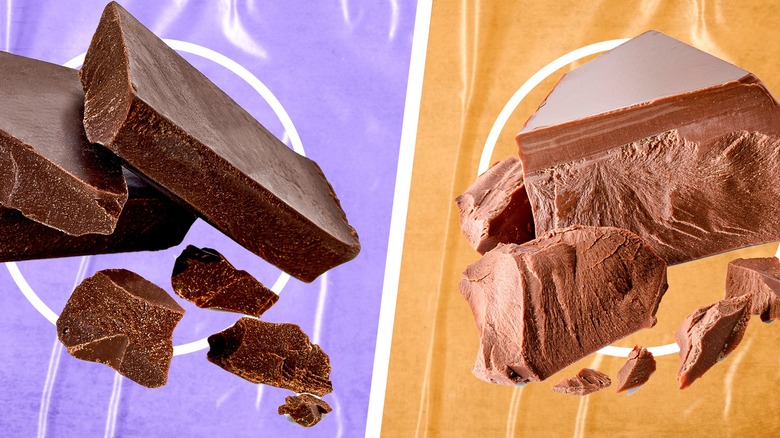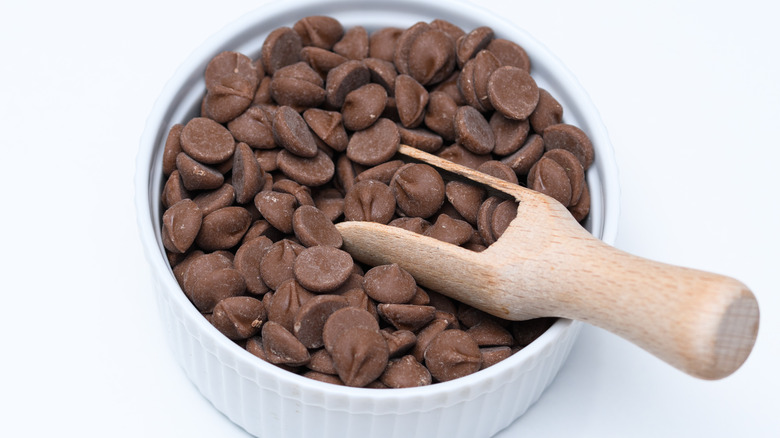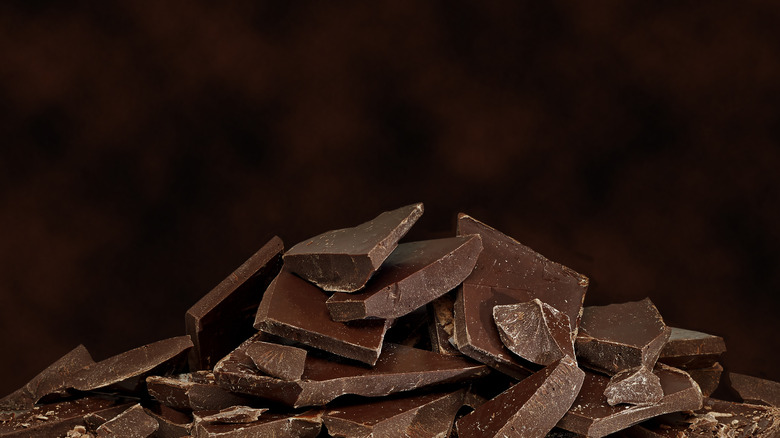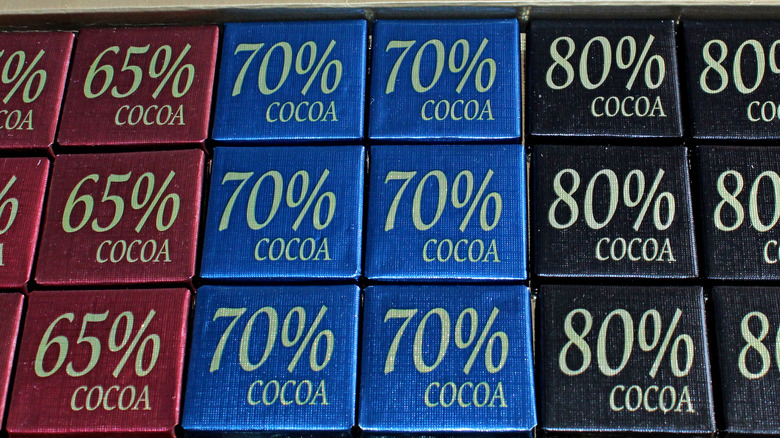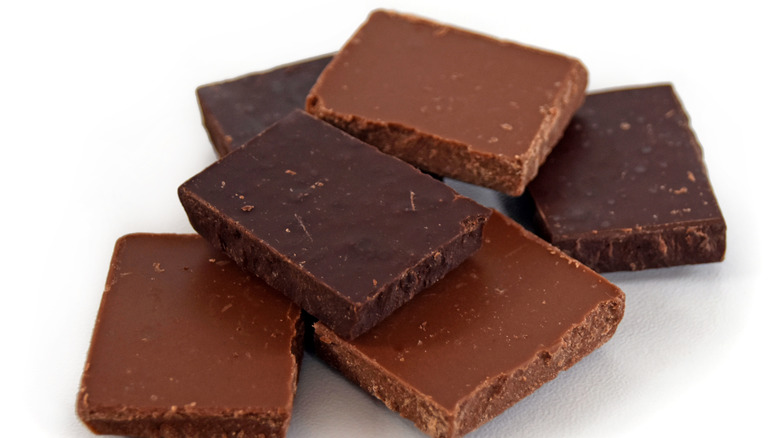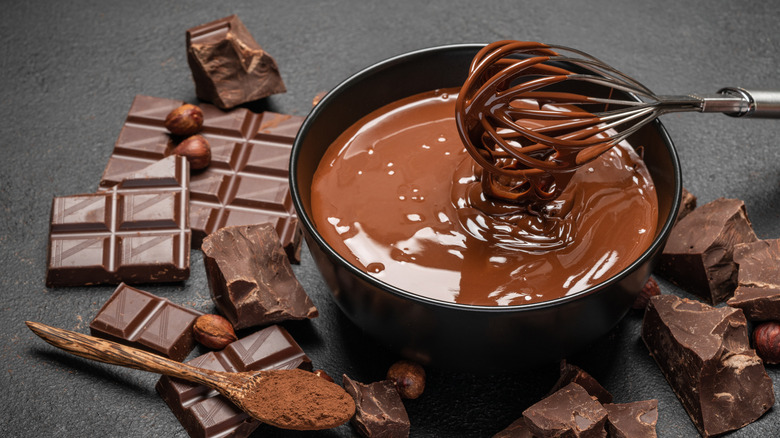Semi-Sweet Vs Bittersweet Chocolate: What's The Difference?
If you want to make a people-pleasing dessert, chocolate is the star ingredient you're looking for. We shave it into ice cream, powder it into our milkshakes, turn it into syrup for our sundae, and frosting for our cakes. Chocolate, though relatively new to the food scene when compared with ancient eats like butter, has taken the world by storm over the past few centuries and is now our go-to treat.
And though most of us only see chocolate presented to us in a candy wrapper, thanks to a few educational cartoons growing up, we know that chocolate comes from the cocoa bean, which is where we source the cocoa butter and nibs we need to create cacao liquor. Sugar and other supplementary ingredients are then added to the cacao liquor to create the chocolate we are familiar with. But as we are all aware, chocolate isn't consistent. Depending on the brand, the percentage of cocoa, and even the type of cocoa used all affect how sweet or dark a batch of chocolate tastes.
I've done my fair share of research into different chocolate varieties for home use, as well as quite a few taste tests of these varying ingredients during a long career in food service. One thing is certain, semi-sweet and bittersweet chocolate, while comparable, have plenty of distinct differences (and uses) to them.
What is semi-sweet chocolate?
If you are one of those people who like to swoop down the candy aisle at the supermarket to snatch a chocolate bar, you are probably most familiar with milk chocolate. But what about semi-sweet? Semi-sweet chocolate is a kind of dark chocolate, but due to the market's variability in flavor and quality, there is no standard for how much sugar is in semi-sweet, though it does commonly have vanilla added.
If you picked up a bag of semi-sweet chocolate chips from the Hershey's brand and compared it to the higher-end brand Lindt, you'd most likely note a difference in sweetness and in the percentage of cocoa in the chocolate itself. As a general but not steadfast rule, semi-sweet chocolate does not have over 50% sugar and is supposed to be a balance between the natural bitterness of the cocoa and sugary sweetness. It is the smooth taste of semi-sweet, which makes this style of chocolate easy to use in any recipe. Where milk chocolate can be too cloying and dark chocolate too dense, semi-sweet is the perfect in-between to bridge the gap.
What is bittersweet chocolate?
As its name suggests, bittersweet chocolate is on the darker side of the flavor sliding scale. Unlike semi-sweet chocolate, bittersweet chocolate is noticeably higher in cocoa percentage — averaging 70% —with comparatively little sugar added to curb the natural intensity of the cocoa liquor. If you've ever bitten into a chunk of bittersweet chocolate, you've probably noticed that it is grittier and less sweet than what you're used to. It probably dried out your mouth a bit as well. But it is hard to mistake bittersweet chocolate for true dark chocolate, which is above 75% cocoa.
Bittersweet chocolate is considered a step up in chocolate intensity from semi-sweet, but it can be difficult to differentiate them at times because chocolate brands on the market can list semisweet and bittersweet chocolates anywhere between 54% to more than 70% cacao. This means that a semi-sweet chocolate bar from one brand may have the same intensity as a bittersweet chocolate bar from another and vice versa.
Cocoa percentage
Simply put, cocoa or cacao percentage refers to the amount of cocoa used to make a particular kind of chocolate. In greater detail, Theo Chocolate explains that the cocoa percentage is the actual amount of chocolate that was derived from a cocoa pod. The measurement includes the amount of cocoa butter, nibs, and cocoa liquor used in production. The cocoa percentage is calculated by dividing the cocoa mass by the overall weight of the chocolate bar. The process may sound a bit complicated, but fortunately, you do not have to worry about it because most reputable chocolate companies print the cocoa percentage on the front of their packaging. The remaining percent of the bar (for example: the unmentioned 30% to your 70% dark chocolate) explains how much of the bar is made of sugar, milk, oil, or other ingredients.
Surprisingly, the spectrum of cocoa percentages is quite broad when it comes to each type of chocolate, even when you're only looking at dark chocolates, like bittersweet and semi-sweet. However, there are a few basic guidelines that help categorize their classification and assist you in choosing the right product for your preference or recipe. For semi-sweet chocolate, the cocoa percentage ranges from 35 to 65%. The cocoa percentage of bittersweet chocolate ranges from 65 to 80%. If you prefer a more decadent chocolate with less sweetness, stick to the higher end of each range — above 80% is regarded as bitter.
Difference in flavor
While both bittersweet and semi-sweet are considered dark chocolates, the flavor of each is noticeably different due to varying cocoa percentages and amounts of sugar. As the name denotes, bittersweet chocolate has a slightly astringent taste balanced by a bit of sweetness. It is not cloying or overly rich. Numerous bittersweet chocolates also feature subtle fruity notes, which add to the complex flavor. Many chocolate lovers prefer bittersweet chocolate because of its terraceous flavor. It is also a favorite for people who want to cut back on their sugar consumption.
Semi-sweet chocolate is sweeter than bittersweet chocolate. The sweeter flavor is due to a lower cocoa percentage and a higher sugar content. The sugary taste is also amplified in some brands due to the addition of vanilla. Additionally, semi-sweet chocolate has a significantly deeper, more potent flavor than milk chocolate. Think of it as the happy medium between milk chocolates and bittersweet chocolates.
Difference in texture
Another noticeable difference between semi-sweet and bittersweet chocolate lies in its texture. While you probably won't be able to tell the difference just by touching it, these kinds of chocolate typically feel different in your mouth. The difference in consistency is also easy to gauge when you crumble or break the two types of chocolate into pieces, either for a recipe or immediate consumption.
Semi-sweet chocolate has a smooth, creamy texture that quickly melts in your mouth. Bittersweet chocolate is drier and more crumbly and brittle than semi-sweet, so it doesn't give you the same melty sensation on your tongue. While production can play a role in the texture of a particular type of chocolate, the difference is primarily due to the amount of cocoa butter used in the recipe. More cocoa butter equals a higher fat content. Unsurprisingly, semi-sweet chocolate has a higher fat content than bittersweet chocolate, giving it an indulgent flavor and a velvety feel. This higher fat content of semi-sweet chocolate also allows it to melt more easily when cooking, making it an excellent choice for sauces and baking recipes.
Color difference between semi-sweet and bittersweet
The final difference between bittersweet and semi-sweet chocolate is the color. Lucky for you, this variation does not require any labels or calculations; it can be identified just by looking. If you place two pieces of chocolate side by side, one bittersweet and the other semi-sweet, the bittersweet will be darker. Semi-sweet chocolate is also darker than milk chocolate.
Of course, the actual shade of a piece of chocolate will depend on the cocoa percentage, but as we now know, semi-sweet has less overall cocoa than bittersweet. As a result, it is a lighter shade of brown than bittersweet, which has a higher concentration of cocoa powder. The color of the chocolate also alerts you to the flavor you can expect. Darker chocolates are typically richer and less sugary, and lighter chocolates are generally sweeter. While not at the top of everyone's list of concerns when cooking with chocolate, the color can also alter the aesthetic appeal of some dishes.
Can you substitute one for the other?
Because of this vast lack of standardization when it comes to cocoa percentage and labeling chocolates semi-sweet and bittersweet, they can often be used interchangeably in recipes. Though bittersweet chocolate should traditionally have a darker flavor than semi-sweet, you must double-check your chocolate brands and compare cocoa percentages. Oftentimes a modern recipe will call for a chocolate with a preferred percentage of cocoa rather than a style of chocolate.
Additionally, if you are substituting bittersweet for semisweet or the other way around, you should simply change the amount you add. But if you are working with an older recipe that doesn't list a specific percentage, it's advised that when you replace bittersweet with semisweet, you should combine semi-sweet chocolate with cocoa powder to give it that characteristic bitter note. If you need bittersweet chocolate but only have semi-sweet, reduce the amount of sugar in the recipe. While substituting these chocolates for one another, we encourage you to taste the recipe as you go to make sure you don't over or underdo it. Mix and match to your preference, and at the end of the day, enjoy your chocolatey treat!
